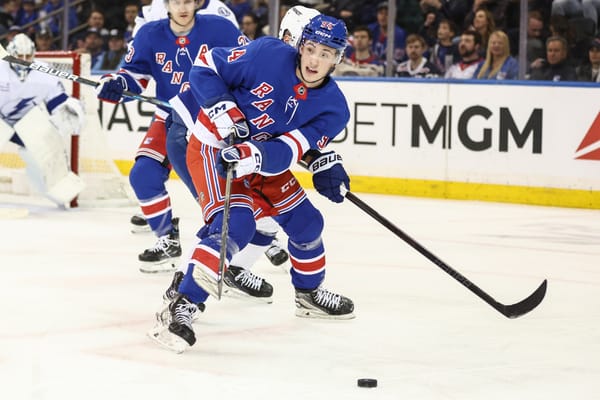What Can Cam Talbot Bring The Rangers in a Trade?
The surprising play of Cam Talbot is surely catching the eyes of a few NHL GMs. What will his trade value ultimately be? Here's a look back at recent trades involving goaltenders similar to Talbot.
A few days ago Joe published this article discussing the idea of a Cam Talbot trade. But you know what? I'm going to write my own article about a potential Talbot trade. You know why? Because I can. It's not like Joe has any say in what I do. And he smells, anyway. Trust me. I've met him.
As should be obvious by now, Cam Talbot's trade value is as high as it's ever going to be. Unless he just completely implodes in the final few games before Lundqvist's return, Talbot will be on the radars of at least a few NHL GMs this summer. Thus, Rangers' General Manager Glen Sather would be remiss to not at least entertain offers on the surging goaltender who will almost definitely leave the team as a free agent in 2016.
On the other hand, this season has shown better than any just how important a backup goaltender can be. Having a quality backup who can step in and keep the team afloat at the perfectly reasonable price of $1.45M is a good asset to have. The Rangers clearly won't just give Talbot away. The returning piece(s) would have to outweigh the merits to keeping him for another season.
What would teams be willing to give up for Talbot? We can't know the exact market for Talbot, but we can look back in recent history for some context. Let's take a look at what goaltenders is similar situations to Talbot have brought back in trades.
March 2nd, 2015: The Buffalo Sabres Acquire a 3rd-round Pick and Chad Johnson From the New York Islanders in Return for Michal Neuvirth.
The most recent trade of a similar instance, Neuvirth, 26, had split starts in Washington for a few years before being relegated to backup and then eventually traded to Buffalo. This season, behind a disastrous Sabres team, Neuvirth was one of the few bright spots and amazingly posted a .918 Save Percentage in 27 starts. That includes an astounding .935 Save % in 17 games since January 1st. Johnson was a throw-in. The third-round pick is for 2016, and will probably be in the latter-half of the round.
Neuvirth and Talbot are similar in age and track record, though Neuvirth definitely has a bit more on his resumé. Where the similarities start to fracture are in the timing of the trade and contract status. The Islanders' essentially picked up Neuvirth as insurance for Halak and at a reasonable cost to upgrade on Chad Johnson. Neuvirth is going to be a free agent at the end of this season, and Buffalo had nothing to gain in keeping him. Thus, they were always going to take the best available offer. If Neuvirth was under contract for another season then would Buffalo have received a better offer in the summer? That seems likely. Even if that only meant a marginal addition such as a late-round pick tacked on.
January 14th, 2015: The Arizona Coyotes Acquire a 3rd-round Pick From the Minnesota Wild in Return for Devan Dubnyk.
Like Neuvirth, Dubnyk also had a few seasons of splitting goaltending duties on his resumé. Dubnyk had two solid seasons with the Oilers before taking a nosedive in 2013 and posting a .894 Save Percentage with the Oilers before being demoted in favor of Ilya Bryzgalov (seriously). Dubnyk was traded to Nashville for Matt Hendricks, who a few months later sent him to Montreal, only to spend the rest of the season in the AHL.
Dubnyk built himself back up this season, though, as Mike Smith's backup in Arizona. While Smith struggled to find his game, Dubnyk won his fair share of games and posted a .916 Save Percentage. Now with the Wild, Dubnyk is an stunning 21-5-1 with a .939 Save Percentage and has almost singlehandedly salvaged Minnesota's playoff aspirations.
Like Neuvirth, Dubnyk had much more of a resumé to go off of. But there are still a number of similarities to found. Dubnyk is more than a quick rental for Minnesota, having been brought in during January, and also was a bit more of a question mark; for a slightly different reason than Talbot is. Whereas NHL GMs are trying to figure out if Talbot is for real, Minnesota had to weigh whether the Arizona version of Dubnyk or the 2013 Edmonton version of Dubnyk was the fluke. It's easy, in hindsight, to say which Dubnyk was legitimate, but at the time of the trade it was a reasonable concern for GMs to have and it surely affected his trade value.
March 5th, 2014: The Calgary Flames Acquire a 2nd-Round Pick from the Colorado Avalanche in Return for Reto Berra
There's always one outlandish event that will always throw a wrench in a consistent precedent, and this trade is the instance in this scenario. You might not know who Reto Berra is, and that's okay. Because you really shouldn't know. A fourth-round pick of the St. Louis Blues in 2006, Berra started his career in Switzerland and for a long time never left. St. Louis threw him into the 2013 trade that brought them Jay Bouwmeester.
Berra, at the age of 26, finally transitioned over to North America. He registered a .908 Save Percentage in 9 AHL games and a .897 Save Percentage in 29 games with Calgary before Colorado inexplicably sent Calgary a 2nd-round pick for the Swiss goaltender and promptly extending him for three years at a $1.45M cap hit. In 16 games with the Avalanche over the last two seasons, Berra has a .875 Save %. He lost the backup job to Calvin Pickard, and now Berra is an expensive AHL goaltender. It seems virtually impossible that this move is salvaged in any way for Colorado.
Berra and Talbot are similar in that they started their NHL careers around the same time and have similar playing time in the NHL. That's it, though. Berra has no NHL success to his name. He doesn't even have the AHL track record that Talbot has. The point of including this trade is to point out how sometimes weird things just happen for no particular reason at all.
March 4th, 2014: The Anaheim Ducks Acquire a 3rd- and 5th-round pick From the Edmonton Oilers in return for Viktor Fasth
The 2014 Anaheim Ducks were a bizarre team. Usually a team that goes through four different goaltenders is have a trainwreck season, but the Ducks were one of the best in the NHL. They just had four extremely good goaltenders in Jonas Hiller, Frederik Andersen, John Gibson, and Viktor Fasth. Fasth was a free agent signing out of the Swedish Elite League in 2013 and made his NHL debut at 30 years old. He boasted a .915 Save Percentage behind a great Anaheim team in 30 career games. The Ducks needed to create some breathing room in net, and Fasth was picked as the odd-man out. The Oilers, desperate for goaltending depth, swapped a 2014 5th and a 2015 3rd to Anaheim in return for Fasth, who was under contract for another season. Since moving to Edmonton, Fasth has a miserable .888 Save Percentage in 33 games and is currently dealing with a knee injury.
Like Talbot, Fasth was a free agent signing who had some quality appearances behind a very good team. And like Fasth, Talbot will be under contract for a full season if a team picks him up. Fasth is nearly five years older, though, so a team acquiring Talbot would have the ability to commit long-term; Fasth was more of a stopgap for Edmonton.
January 15th, 2014: Los Angeles Acquires a 3rd-Round Pick From Edmonton in Return for Ben Scrivens
Having acquired Scrivens as part of the Jonathan Bernier trade to Toronto, Scrivens took advantage of a Jonathan Quick injury and posted a .931 Save Percentage in 19 games with the Los Angeles Kings. Also playing well in that span was 23-year-old goaltender Martin Jones, who looked ready for the NHL. The Kings had a decision to make upon Quick's return, and they ultimately decided to move Scrivens to the Oilers, who were desperate for goaltending and had just earlier traded Devan Dubnyk.
Scrivens started out extremely hot with Edmonton, posting a .931 Save Percentage in his first 15 games with the team. It's going downhill, though, with him averaging .907 since, including just .897 this season. Some of that is very obviously because of how bad Edmonton is, though it also seems likely that Scrivens is not that .930 goaltender he appeared to be in Los Angeles, either.
Scrivens is probably the best comparison we're going to find for Talbot. They both were undrafted free agent signings out of the NCAA. They both spent a good amount of time in the AHL, putting up solid numbers there before finding a home in the NHL in their mid-20s. And both have taken advantage of a goaltending injury and put up great numbers behind very good teams in that opportunity.
Is a Trade Worth it?
The general consensus seems to be that backups who have pushed themselves into discussions about being a potential starter are worth a third-round pick. Again, though, you look at what Retro Berra brought back and have to wonder if there's more to be wrung out of a desperate team.
Also mattering will be what the market for goaltenders looks like. We can safely say that 5-6 teams will be in the market for a starting goaltender while a few others might want a platoon option or someone to challenge their incumbent for the the starting gig. Antti Niemi, Devan Dubnyk, Jhonas Enroth, Michal Neuvirth, Karri Ramo, and Viktor Fasth will be unrestricted free agents, while Ottawa and Toronto could very well trade a goaltender and Cam Ward and Ondrej Pavelec could be on the trade block.
Ultimately, there's going to be a trade to make regarding Talbot. Someone is going to want him. The question is going to be if the offer is good enough to justify moving him. If history holds true, then I'm not sure a third-round pick is enough to entice me, personally. The Rangers are going to hope to contend again next year, and I don't think a third-round pick offsets the loss of a goaltender at a reasonable price of $1.45M whom you can trust in 20-22 starts and who could hold the fort in case of a Lundqvist injury.
On the other hand, Talbot in not irreplaceable, and the Rangers badly need to recoup some draft picks with all the moves they have made in recent years. A second-round pick (and anything better) would force me to pull the trigger, and I'd think very hard about two third-round picks. Perhaps there's a compromise to be made in a conditional third round pick and a late-round pick, with the third-rounder turning into a second-rounder should Talbot sign an extension with that team.
In any case, this is not something the Rangers are going to start worrying about until they have their organizational meeting in late May or early June. For now, we can simply enjoy the last few starts that Talbot makes before Lundqvist returns to his throne and hope that he makes the best of them, pushing his trade value that much higher.




